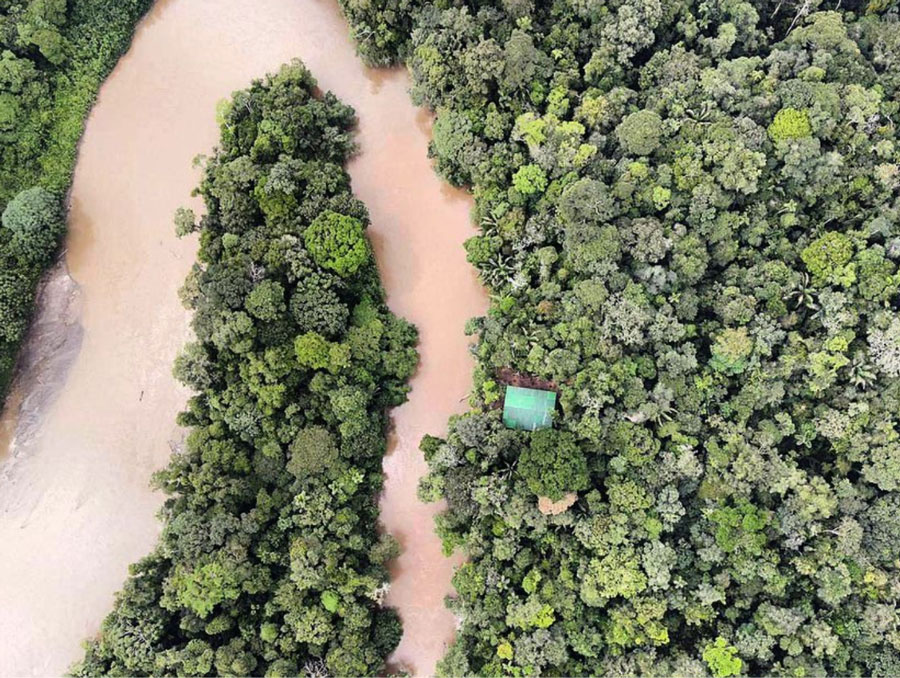A multi-disciplinary group of researchers including four professors from the Hitchcock Center for Chemical Ecology was recently awarded a $3 million National Science Foundation (NSF) Rules of Life grant to better understand how climate change, the global push for clean energy and related global demand is impacting biodiversity within the Amazon basin. Central to this research is collaboration with Indigenous Kichwa and Waorani families in Ecuador, incorporating their Traditional Knowledge of the local forest in the group’s approach to examining tropical species interaction. Their extensive Traditional Knowledge of the plant and animal life in the Amazon basin will serve as a foundation for the group’s research, informing the data gleaned from the most recent scientific methods in chemistry, biology, mathematics, anthropology and the humanities. Several members of the research team are members of the Amazonian Kichwa or Waorani nations.
“Indigenous Traditional Knowledge of the local forests in the Amazon has allowed diverse Indigenous Peoples to utilize ecosystem resources in a way that has maintained ecosystem health and diversity over millennia,” Assistant Professor of Biology and the project’s principal investigator (PI) Lora Richards said. “Conventional conservation science has largely left this valuable perspective out.”
The team believes the collaboration could yield profoundly accurate and surprising understandings of species interactions and how to protect biodiversity in the Amazon. They also hope the research will serve as a model for collaboration between Amazonian Indigenous communities and academic researchers that respects and values Traditional Indigenous Knowledge, acknowledges Indigenous contributions to research and provides sustaining benefits to these communities.
A tangled web of interactions
“Loss of biodiversity is one of the most profound global changes that currently affects all ecosystems and Indigenous Peoples. Factors such as chemical diversity are far less understood yet are likely a ubiquitous component of environmental degradation.”
Climate change is having a significant impact on biodiversity loss around the world, and while the global push to reduce carbon emissions has been successful in increasing the use of clean energy generation such as solar, wind and geothermal energy, an unintended consequence is sometimes more biodiversity loss. In Ecuador, a recent threat to the rainforest ecosystem comes from the large-scale harvesting of wild balsa, a common lightweight tropical tree used in the construction of wind turbines. The growing demand for wind power led by the world’s two largest economies – the U.S. and China – made 2020 the best year yet for the industry. In response to ambitious targets for reducing the use of fossil fuels along with a slew of tax credits and subsidies to support green energy, a 53% year-on-year global increase in wind energy generation outpaced the supply of balsa in Ecuador which provides 95% of the lumber to the world. At the same time, global trade was bottlenecked by the COVID-19 pandemic, increasing demand even more. The price for balsa skyrocketed and large swaths of rainforest were quickly cleared of the tall trees, dramatically altering the landscape.
“There was an uncontrollable rush to extract balsa,” Co-PI and Associate Professor of Religious Studies at Arizona State University Tod Swanson said. Swanson grew up in the Ecuadorian Amazon and is a member of his wife and daughter’s Santu Urku Kichwa community. “It’s an example of boom cycles of extraction in the Amazon. We never know what the next one is going to be.”
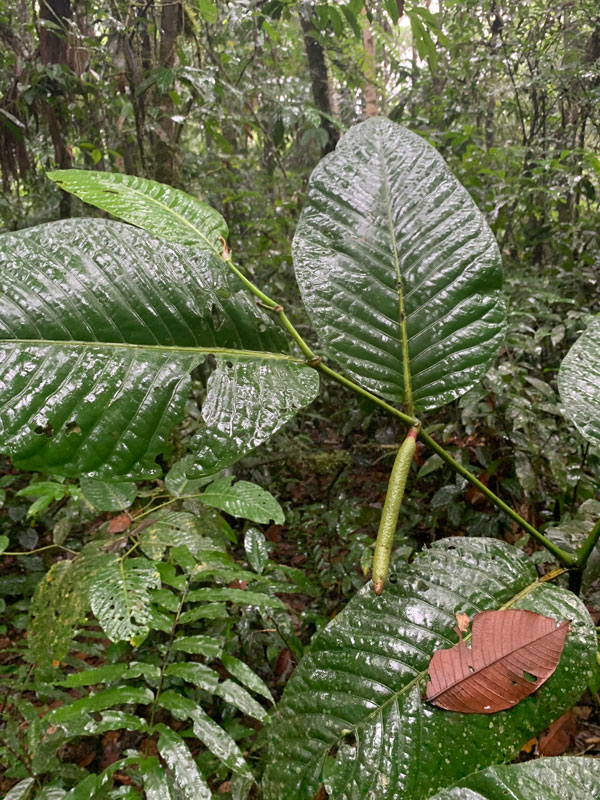
With the end of China’s key wind power subsidies in 2021 and the early impacts of the pandemic on trade dissipating, balsa extraction has slowed almost as quickly as it started. As the forest ecosystem attempts to recover from this most recent rush for resources, the researchers have a unique opportunity to witness the rainforest’s complex biological network rebuild itself. Amidst this vast forest of biodiversity, the group chose one plant genus on which to focus their research: Piper. From the black pepper family, Piper provides important medicinal value to the Kichwa and Waorani and their Traditional Knowledge of the plant is vast. It has been used for everything from numbing a toothache to curing tumors. A common species of Piper has been used effectively in Ecuador’s Indigenous communities as astringent steam inhaled to help clear the lungs during the COVID-19 pandemic. The group’s understanding of the plant from the biological perspective is also extensive. Richards’s colleague and professor of biology Lee Dyer has been studying Piper at Yanayacu Biological Station in Ecuador for the past 22 years. Of particular interest to Richards, Dyer and the other members of the Hitchcock Center for Chemical Ecology is the role Piper’s chemical makeup plays in the plant’s coevolution with other species. Two Piper plants, while of the same species, may have dramatically different chemical makeups based on the soil they grow in, the plants they share space with, the bugs that eat or don’t eat them and many other factors. Already bolstered with 15 years of data on Piper’s relationship to different organisms in the food chain and fascinating findings by the group’s organic chemists, professors Chris Jeffrey and Craig Dodson as well as postdoctoral scholar Casey Philbin, they plan to continue to track how Piper found across the landscape, including the forests disturbed by balsa harvesting, differs chemically and how those chemical differences alter their role within the rainforest ecosystem. The researchers hypothesize that global change and events like the rapid extraction of balsa is diminishing chemical diversity within species and that a loss of chemical diversity could have cascading ecosystem effects, similar to the extinction of a species.
“Loss of biodiversity is one of the most profound global changes that currently affects all ecosystems and Indigenous Peoples,” Richards said. “Factors such as chemical diversity are far less understood yet are likely a ubiquitous component of environmental degradation.”
“Being an Amazonian Kichwa woman means that I understand that the forest is a ‘kawsak sacha’ (alive or a live forest). We live as relatives with the land and understand that we are not separate from nature but rather an extension of nature."
Parallel to the audit of Piper’s chemical and genetic information, the group will collect consensually recorded interviews with members of Waorani and Kichwa communities as they describe their knowledge of different tropical species and how they identify and make use of native plants. These interviews will take place at the Iyarina Research Station founded by Swanson and located in the Santu Urku Kichwa community as well as two extension sites run by Waorani families. These communities include elders in their 50s and 60s with deep Traditional Knowledge who are primarily monolingual – speaking either Wao Tededo, the Waorani language, or Kichwa – as well as younger members who are bi- or trilingual in their native language and Spanish and/or English and have experience working with nonprofit organizations, scientists and advanced research technology. Many of these young Native Amazonians are members of Inti Anka Taripay, an association of Kichwa college graduates dedicated to promoting the use of the Kichwa language in academic contexts and encouraging Kichwa people to pursue careers in STEM fields. Elizabeth Swanson Andi, president of Iyarina Research Station and communications director for Inti Anka Taripay, will assist her father, Swanson in the interview and transcription process.
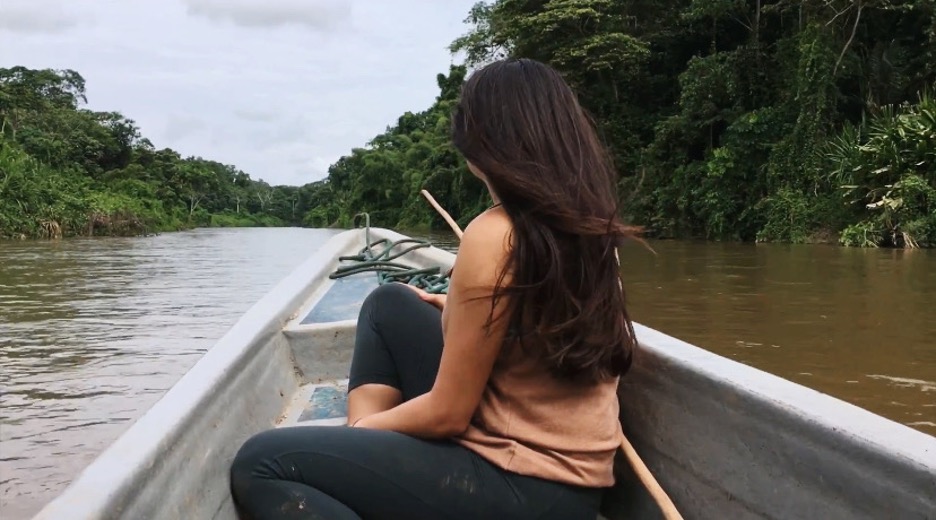
“Being an Amazonian Kichwa woman means that I understand that the forest is a ‘kawsak sacha’ (alive or a live forest),” Swanson Andi said. “We live as relatives with the land and understand that we are not separate from nature but rather an extension of nature. It is believed that the forest where we reside knows us through those who came before, meaning our parents and grandparents. If I were to go to a different forest, even though it may be relatively close, that specific forest does not know me personally and the way I approach it will change. During the interviews with the elders, I expect to hear about their social and emotional relationship with nature, themes of change, loss, and joy (the ideas of ‘iyarina’ and ‘llakina’ in Kichwa), experiences between the dream and physical world, and the knowledge on resources acquired through social relationships with the land or with specific beings. I think in some ways what we will find may align with Western science, but I also think that there will be many surprises and opportunities to understand living beings from a different, yet incredibly valuable perspective.”
Leaving room for profound surprise
“Usually if you have a collaboration like this, the Indigenous communities are not competing on equal footing. You have academic researchers and a project that’s funded broadly in the sciences, and so you’re going to control the variables and use basic scientific methods. Indigenous thinking is just very different."
While both Traditional and scientific knowledge are acquired through careful observation, the methods and underlying assumptions they employ differ significantly. The group hopes to overcome the challenge of balancing the disparate ways of thinking by listening carefully to how species are classified the Kichwa and Waorani languages. This Indigenous classification system will be used to create a framework for comparing the scientific analyses of Piper’s chemical diversity and environmental variables. Contrary to standard scientific thinking where a fixed number of species is defined by set characteristics, the Indigenous worldview, according to Swanson’s earlier research, emphasizes a relational identity. The identity of a species is made up of its complex relations and those relations are always changing, more than conventional science would allow. The researchers believe their emerging understanding of chemical variation within a single genus may align more harmoniously with the Indigenous worldview.
“Essentially what they’re describing are ecological networks which align with how we look at chemotypic variation and the interactions of plants with caterpillars higher in the food chain,” Richards said. “We would not expect the same plant in different environments with different soil to be chemically identical to each other. Similarly, the Waorani may assume the same plant in different environments would behave differently.”
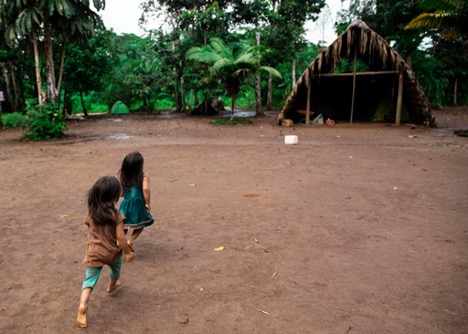 Granddaughters of Ore Nenquimo and Omanca Enqueri run around in their community, the Waorani community of Gomataon. Interviews with members of communities like this one are key to the profound understandings of plant and animal interactions. (Photo by Elizabeth Swanson Andi)
Granddaughters of Ore Nenquimo and Omanca Enqueri run around in their community, the Waorani community of Gomataon. Interviews with members of communities like this one are key to the profound understandings of plant and animal interactions. (Photo by Elizabeth Swanson Andi)The non-Indigenous academic researchers hope their experience collaborating across scientific disciplines has prepared them to work effectively with their Indigenous counterparts.
“Our team has a really strong history of collaborating across disciplines and one thing that we know is that you don’t force any field into one field’s format of success,” Richards said. “We are not going to try and force Traditional Knowledge into our box of science or force our science on the way we explore Traditional Knowledge. We’re going to let the research go where it takes us.”
“Usually if you have a collaboration like this, the Indigenous communities are not competing on equal footing,” Swanson said. “You have academic researchers and a project that’s funded broadly in the sciences, and so you’re going to control the variables and use basic scientific methods. Indigenous thinking is just very different. This is a community of people who in a practical way have engaged with this environment for centuries, know how it works, are expert hunters, know where the animals are going to be and know how the plants are going to act. They see plants and animals as human-like, maybe even as human in a previous life. That is such a jump from there to western knowledge that sometimes scientists discard the mythology and anything they think is not going to lead to a prior or something to put into data. If you do this, you write off the surprise and the opportunity to have a new thought that could lead somewhere. We plan to really listen and see where it leads us.”
Sustaining the Indigenous culture through research
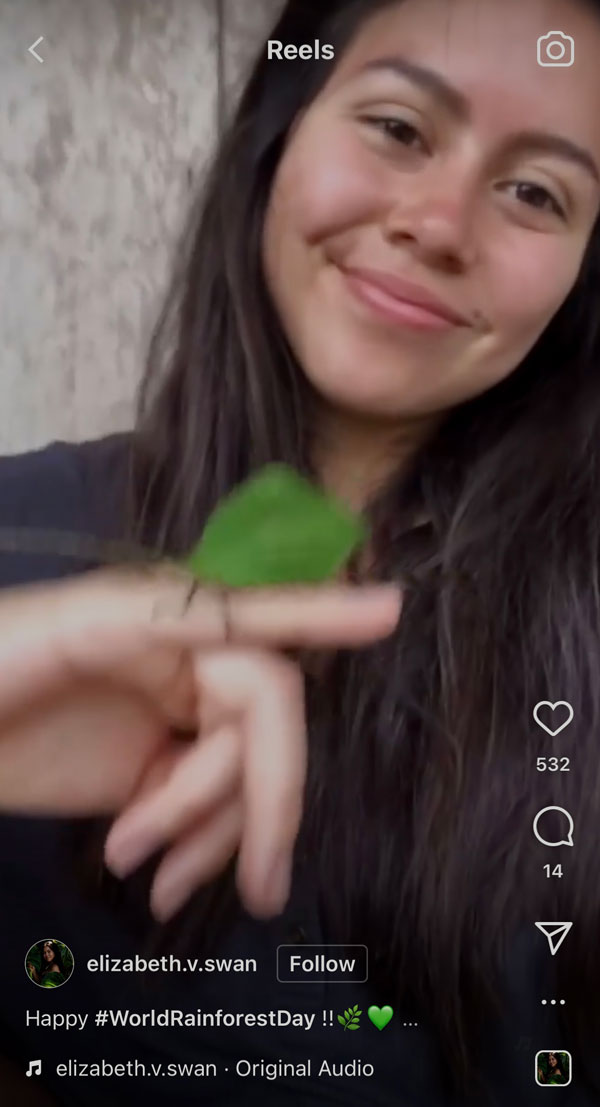
This research comes at a time of transition within the Amazonian Indigenous communities. There is a growing urban population of Waorani and Kichwa, mostly young Amazonians, who have maintained much of their culture but are also attending urban schools, engaging with technology and social media, and seeking employment, often out of necessity, with companies over-extracting rainforest resources like balsa. The funding for this research will provide an alternative, sustainable source of employment for these communities. The three field stations where the research will take place are Indigenous-run, in collaboration with Swanson, with Indigenous employees and administration. This project will help to provide periodic jobs sustained for over five years and the researchers hope the collaboration will set the foundation for more projects and continued employment at these sites. Diana Chavez Vargas, an enrolled member of the Comuna San Jacinto Amazonian Kichwa Community will coordinate logistics with the Indigenous communities for the project and integrate long-term goals for continued collaborations in Ecuador’s Indigenous territories. Chavez Vargas received her Bachelor’s in business administration from Universidad San Francisco de Quito and recently obtained a Master's in Indigenous planning from the University of New Mexico, Albuquerque.
In addition to the economic benefits, the group believes they must act now to preserve the Indigenous culture for future generations – another pivotal goal of the research.
“My grandmother is a monolingual Kichwa speaker and when she was young there were abundant animals, forest and clear streams,” Swanson Andi said. “She lost her gardens and land to settlers called colonos and had to move to new lands across the river. Later a road passed through and during my lifetime that road was paved, electricity arrived, and wildlife began to disappear. Now our Kichwa community faces language loss, forest degradation, water and food insecurity. When I look at the land, I not only think about what happened there during my lifetime but that of my mother’s and grandmother’s. As I remember, I feel great ‘llaki’ – a feeling of empathy, sorrow, and love all at once – leading me to ‘kuyana’ – the action of reciprocity and giving back. My role on this team is also my responsibility to the land and relatives who shaped me. Recording Indigenous elders and making sure that our stories and knowledge remain alive is how I give back to my community.”
The project’s recorded conversations with Indigenous community members will be edited into five-minute videos with subtitles in Wao Tededo, English and Spanish and made publicly available.
The NSF Rules of Life grant was awarded in January of 2022 and will provide five years of funding. The group of scientific researchers, Amazonian Indigenous leaders, anthropologists and students across a range of disciplines hope the resulting findings will be reflective of the unique and diverse perspectives of their team.
“It’s not just this group’s high academic capabilities, but their human qualities of openness and adventure and their interest in the future of the Amazon that will make this project successful,” Swanson said. “This is going to be revolutionary and eye-opening in a number of areas if we can really pause and think about the surprises.”
